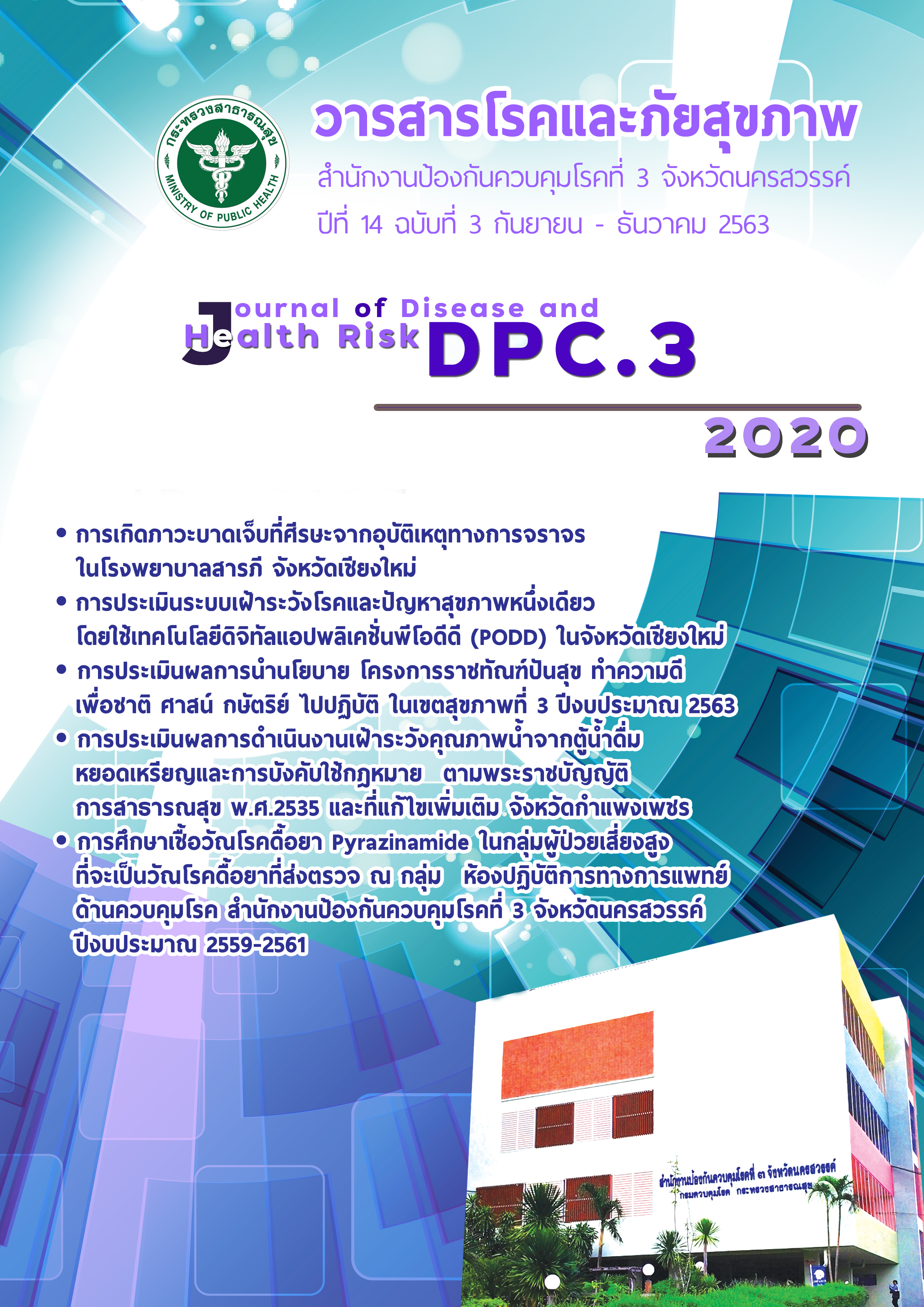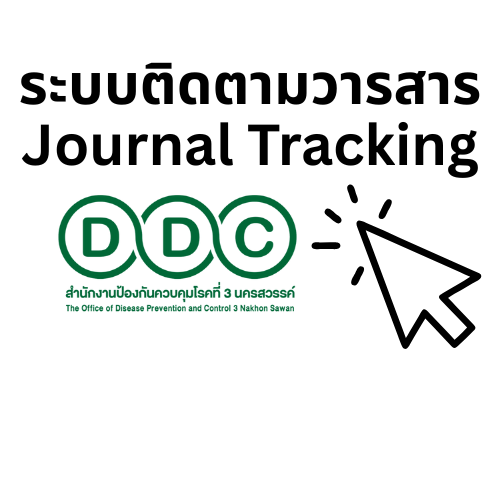Title: Incidence of Traffic Accident Traumatic Brain Injury in Saraphi Hospital, Chiangmai.
Keywords:
อุบัติเหตุการจราจร, อุบัติการณ์ภาวะบาดเจ็บที่ศีรษะ, โรงพยาบาลสารภี จังหวัดเชียงใหม่Abstract
The purposes of this research were study incidence of traffic accident traumatic brain injury, pattern of cranial injury, treatment outcome and cost of treatment of traumatic brain injury case in Saraphi hospital, Chiangmai. This retrospective study was performed 208 cases of traffic accident traumatic brain injury by medical records collecting in 1 October 2018 to 30 September 2019. Data was analyzed by descriptive statistic, Chi-square correlation and Logistic regression. The results revealed that total traffic accident cases in Saraphi hospital are 504 cases, incidence of traumatic brain injury case are 208 cases (38.5%). Most of injured sample was male, age between 21-40 year old and mostly Thai nationalities. Motorcycle was used for transport frequently, no personal protective equipment, and mostly no alcohol drinking during driving. Time of injury was frequently in 4.01 p.m. - 12.00 p.m. The factors related to low Glasgow coma scale during discharge from hospital are male p= 0.002, alcoholic drinking p< 0.001 and time of injury 00.01 a.m.- 08.00 a.m. p< 0.001. The research suggests the direction to plan strategies for safety driving reduce traffic accident in Saraphi district especially male people to use personal protective equipment, no alcoholic drinking during driving and not driving at night time.
References
Corrado IACCARINO, Alessandro CARETTA, Federico NICOLOSI, et al. Epidemiology of Se-vere Traumatic Brain Injury. JOURNAL OF NEUROSURGICAL SCIENCES. 2018; 62 (5): 535- 541.
สำนักงานนโยบายและแผนการขนส่งและจราจร.รายงานการวิเคราะห์สถานการณ์อุบัติเหตุทางถนนของกระทรวงคมนาคม พ.ศ. 2561. สำนักแผนความปลอดภัย กลุ่มพัฒนาความปลอดภัย. 2562.
Muhammad Junaid, Mamoon- ur- Rashid, Afreera Afsheen, et al. Changing Spectrum of Traumatic Head Injury: Demographics and Out-come Analysis in a Tertiary care Referral Center. J Pak Med Assoc. 2016; 66 (7): 864- 868
Rita de Cassia Vieira, Wellingson Silva Pavira, Daniel Vieirade Oliveira, et al. Diffuse Axonal Injury: Epidemiology, Outcome and Associated Risk Factors. Frontier in Neurology. 2016; 7. Article 178.
ธิดา ธรรมรักษา บุปผา ลาภทวี และ อมรพล กันเลิศ. ปัจจัยที่เกี่ยวข้องกับความรุนแรงและการบาดเจ็บในผู้ประสบอุบัติเหตุจราจรในหอผู้ป่ วยศัลยกรรมอุบัติเหตุและฉุกเฉินโรงพยาบาลธรรมศาสตร์เฉลิมพระเกียรติ. วารสารโรงพยาบาลธรรมศาสตร์เฉลิมพระเกียรติ.2559; 1 (1):13- 25.
สิริหญิง ทิพศรีราช และ ภิรมย์ อินทะพันธุ์. ระบาดวิทยาและการพยากรณ์การบาดเจ็บจากการขนส่งทางบก พื้นที่ภาคเหนือตอนบน ปี 2556. กลุ่มระบาดวิทยาและข่าวกรอง สำนักงานป้ องกันควบคุมโรคที่10 เชียงใหม่. 2557.
Anil Kumar Singh, Rajan Kumar Jena, Ranabir Pal.,et al. Morbidity Audit of Traumatic Brain Injury Cases in Dedicated South Indian Trauma Center. Asian Journal of Neurosurgery. 2018; 13 (3): 714- 720.
Navdeep Singh Saini, VikasRampal, YashbirD-ewan,et al. Factors Predicting Outcome in Patients with Severe Head Injury: Multivariate Analysis. THE INDIAN JOURNAL OF NEUROTRAUMA. 2012; 9: 45- 48.
ประดิษฐ์ รุ่งพิบูลย์โสภิษฐ์. การเสียชีวิตของผู้ป่ วยที่ได้รับบาดเจ็บจากอุบัติเหตุของโรงพยาบาลกำแพงเพชร. วารสารโรงพยาบาลกำแพงเพชร.2549: 11-22.
Micheal C. Dewan, Abbas Rattani, SakSham Gupta, et al. Estimating the Global Incidence of Traumatic Brain Injury. J. Neurosurg. 2018; 27.
Jee- Hye Choi, Pual J . Park, Vuthy Din, et al. Epidemiology and Clinical Management of Traumatic Spine Injuries at a Major Government Hospital in Cambodia. Asian Spine J. 2017; 11(6): 908- 916
Downloads
Published
How to Cite
Issue
Section
License
Copyright (c) 2020 Journal of Disease and Health Risk DPC.3

This work is licensed under a Creative Commons Attribution-NonCommercial-NoDerivatives 4.0 International License.
Copyright notice
Article published in the Journal of Disease and Health Risk DPC.3 Nakhon Sawan. It is considered a work of academic research and analysis as well as the personal opinion of the author. It is not the opinion of the Office of Disease Prevention and Control 3, Nakhon Sawan. Or the editorial team in any way Authors are responsible for their articles.
Privacy Policy
Name, address and e-mail address specified in the Journal of Disease and Health Risk DPC.3 Nakhon Sawan. It is used for identification purposes of the journal. And will not be used for any other purpose. Or to another person.









